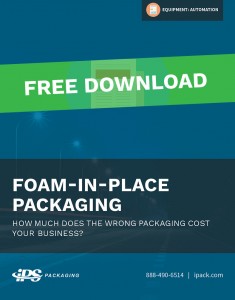Foam in place: Offering new ideas and solutions to your packaging problems
There are many options in the protective packaging industry; whether businesses choose traditional void-fill, packaging peanuts, bubble, micro-foam or other protective packaging solutions, consumers have always had a variety of choices at their fingertips. However, foam in place packaging has remained stagnate with only one option available on the market...until now.
The current foam in place packaging market has been dominated by one line of machines. These machines boast high costs, hard to replace parts and downtime for businesses. What took so long for the packaging industry to get a foam in place line of machines that had lower costs, easy to replace parts and virtually, no downtime? The answer isn't as clear cut as some may think.
What started as an idea conceived by Lockheed Corporation engineers back in the 1950s finally came to fruition in the late 1960s with the help of inventor Richard Sperry. Instapak Corporation was born, and then acquired by a division of Sealed Air Corporation in 1977. Since then, there had been only one foam-in-place packaging solution.
It was revolutionary. And, like all revolutionary ideas, no one was really willing to challenge the original innovators for business.
In 2003, foam packaging veterans got together to discuss and develop new foam-in-place technology. The result of that discussion was a company called IntelliPack.
After being acquired by Pregis Corporation in 2010, IntelliPack has begun to show major strides in the foam in place market.
It took a couple of decades to come up with an ideal competitor to Sealed Air's foam in place packaging. So, what's the big difference between the two systems? First, it's important to consider some basic terminology and understanding of the equipment design.
Some machines can waste foam and/or film. "Cold shot" is a process that results from a gap between the dispenser and the mixing module. When the operator takes a break, or shuts down the machine, and later returns, the first shots are cold. This results in bad or wasted foam. IntelliPack heats all the way from the pump head to the mixing module, eliminating cold shot. Temperature is maintained within one degree of leaving the barrel (even when the operator is away). IntelliPack has also designed the core to only be loaded one way (forwards as opposed to backwards). The easy-feed feature eliminates waste of film for the product. These basic changes of design have helped operators be more efficient with their foam packaging.
httpvh://youtu.be/EzKRv67TN6U
 IntelliPack's 5 degrees of separation provide the difference between their system and traditional foam in place systems.
IntelliPack's 5 degrees of separation provide the difference between their system and traditional foam in place systems.The main difference between traditional foam-in-place systems and the IntelliPack system comes down to the "5 degrees of separation."
- Telemetry: Telemetry collects, monitors and measures information such as foam/film usage, temperature and pressure each time the equipment is operated.
- Bar Coding: Bar coding keeps operators and operations consistent by delivering the right amount of foam and the right amount of film every time.
- Equipment: As talked about previously, the equipment is designed for ergonomic use with easy film deployment, easy to replace parts, user-friendly controls and a rugged mixing module.
- Commitment: Always customer focused, partnering with IntelliPack and IPS ensures businesses that they will always stay connected and continue to be productive with ongoing service.
- Advantage: No up-front capital investment is required; all parts and labor are free; what else is there? The bottom line is money; how you save it and how you maximize it.



